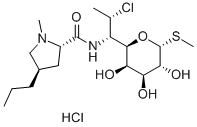Clindamycin hydrochloride
- CAS No.
- 21462-39-5
- Chemical Name:
- Clindamycin hydrochloride
- Synonyms
- CLINDAMYCIN HCL;ClindaMycin-d3;CLEOCIN;Dalacin;7(S)-CHLORO-7-DEOXYLINCOMYCIN;Clindamycin hydrochloride, nonsterile;U-21251F;dalacina;Dalacin S;Clidamacin
- CBNumber:
- CB2398837
- Molecular Formula:
- C18H34Cl2N2O5S
- Molecular Weight:
- 461.44
- MDL Number:
- MFCD07793327
- MOL File:
- 21462-39-5.mol
- MSDS File:
- SDS
| Melting point | 141°C |
|---|---|
| storage temp. | 2-8°C |
| solubility | H2O: 50 mg/mL, clear, colorless |
| color | White to Off-White |
| BRN | 4070786 |
| Stability | Hygroscopic |
| InChIKey | AUODDLQVRAJAJM-XJQDNNTCSA-N |
| SMILES | [C@@H]1([C@@H]([C@H](C)Cl)NC(=O)[C@@H]2C[C@@H](CCC)CN2C)[C@H](O)[C@H](O)[C@H]([C@@H](SC)O1)O.Cl |&1:0,1,2,8,10,17,19,21,22,r| |
| CAS DataBase Reference | 21462-39-5(CAS DataBase Reference) |
| FDA UNII | T20OQ1YN1W |
SAFETY
Risk and Safety Statements
| Symbol(GHS) |  GHS07 |
|---|---|
| Signal word | Warning |
| Hazard statements | H317-H319-H362 |
| Precautionary statements | P260-P263-P280-P302+P352-P305+P351+P338-P308+P313 |
| Hazard Codes | Xi |
| Risk Statements | 36/37/38 |
| Safety Statements | 26-36-37/39 |
| WGK Germany | 2 |
| RTECS | GF2275000 |
| F | 10 |
| HS Code | 29419000 |
Clindamycin hydrochloride price More Price(38)
| Manufacturer | Product number | Product description | CAS number | Packaging | Price | Updated | Buy |
|---|---|---|---|---|---|---|---|
| Sigma-Aldrich | C5269 | Clindamycin hydrochloride lincosamide antibiotic | 21462-39-5 | 10mg | $99.2 | 2024-03-01 | Buy |
| Sigma-Aldrich | C5269 | Clindamycin hydrochloride lincosamide antibiotic | 21462-39-5 | 50mg | $287 | 2024-03-01 | Buy |
| Sigma-Aldrich | C5269 | Clindamycin hydrochloride lincosamide antibiotic | 21462-39-5 | 100mg | $482 | 2024-03-01 | Buy |
| Sigma-Aldrich | C2250000 | Clindamycin hydrochloride European Pharmacopoeia (EP) Reference Standard | 21462-39-5 | c2250000 | $220 | 2024-03-01 | Buy |
| Tocris | 4822 | Clindamycin hydrochloride ≥98%(HPLC) | 21462-39-5 | 50 | $305 | 2021-12-16 | Buy |
Clindamycin hydrochloride Chemical Properties,Uses,Production
Overview
Clindamycin [7-chloro-lincomycin] is a semisynthetic derivative of lincomycin and was introduced in the 1960s as an antibiotic. It is available as clindamycin hydrochloride for oral administration in capsules, as clindamycin phosphate for intramuscular or intravenous injection, and as clindamycin palmitate for oral suspensions[3-5]. In vitro, its spectrum of activity includes staphylococci, streptococci and pneumococci, most anaerobic bacteria [including over 90% of Bacteroides fragilis], Chlamydia trachomatis and certain protozoa. Like penicillin, it has activity against group A and B streptococci, microaerophilic streptococci and most Streptococcus pneumoniae. It does not, however, have activity against the enterococci [3-5]. Like cloxacillin and the cephalosporins, clindamycin possesses activity against Staphylococcus aureus. It has broader anaerobic coverage than most cephalosporins, but has virtually no activity against aerobic Gram-negative bacteria[3, 4]. With its excellent activity against both Gram-positive cocci and Gram-positive or-negative anaerobes, clindamycin has a role in the treatment of head and neck, respiratory, bone and soft tissue, abdominal, and pelvic infections[1-5].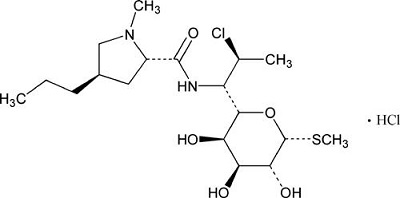
Figure 1 The chemical structure of the clindamycin hydrochloride
Pharmacokinetics
When given orally, clindamycin is well absorbed and peak concentrations are found after about 45 min. It is metabolized into three major, biologically active derivatives and is mainly excreted into the bile, with about 20% excreted by the kidneys[6]. The normal elimination half-life of about 2 to 4 h is not altered in patients with severe renal disease, but impaired liver function leads to a prolongation of elimination[7].
Clindamycin is purportedly well absorbed(90%) from the gastrointestinal tract, and high concentrations are achieved in most tissues including neutrophils, bone(60%) and joints
[85%] but not in the central nervous system. Recent data indicate that the true absorption of clindamycin may be closer to 50%, and, paradoxically, higher levels are obtained in patients with advanced human immunodeficiency virus(HIV) infection[75% absorption], possibly as a result of decreased hepatic metabolism[8]. Previous studies indicating high absorption may have been measuring an inactive metabolite. The drug is metabolized and excreted by the liver, and dose modifications are recommended for hepatic failure or concomitant renal and hepatic dysfunction. The half-life is 2 to 2.5 h, but may be prolonged to 8 to 12 h in patients with severe liver disease[2]. Biliary excretion of active drug and metabolites results in prolonged activity of clindamycin within the intestine, with effects on gastrointestinal flora for up to two weeks. This may be relevant to both the development and duration of Clostridium difficile-associated colitis. Clindamycin is available as oral tablets(150 and 300 mg), parenteral injection(intramuscular or intravenous), and topical and vaginal formulations. Usual parenteral doses are 600 mg every 6 to 8 h to 900 mg every 8 h. Typical oral doses are 150 to 450 mg qid. Topical formulations include a 2% ointment and 2% vaginal gel.
Indication
Clindamycin hydrochloride is used for the treatment of serious infections caused by susceptible anaerobic bacteria, including Peptostreptococcus, anaerobic streptococci, Clostridium, Bacteroides spp., spp., and microaerophilic streptococci[9]. It may be useful in the treatment of polymicrobic infections such as intra-abdominal or pelvic infections, osteomyelitis, diabetic foot ulcers, aspiration pneumonia and dental infections. It is also used for treat MSSA and respiratory infections caused by S. pneumoniae and S. pyogenes in patients who are faced with drug resistance or are intolerant to many other antibiotics. It may also be used vaginally to treat vaginosis caused by Gardnerella vaginosa[9]. Given clindamycin reduces the toxin producing effects of S. aureus and S. pyogenes and as such, it may be particularly useful for treating necrotizing fasciitis. It is also administrated topically to treat acne[9,10].
Furthermore, it is active against organisms such as Plasmodium, Toxoplasma, Babesia, and Pneumocystis spp. Clindamycin is the drug of choice for prophylaxis of Toxoplasma chorioretinitis in newborn infants[11] and is part of recommended regimens against both Babesia microti and Babesia divergens[12]. In combination with pyrimethamine or primaquine, it is an alternative regimen for the treatment of toxoplasmosis and pneumocystosis, respectively[11, 13]. Clinical trials from the 1970s and 1980s have shown the efficacy, safety, and practicability of the treatment of Plasmodium falciparum malaria with clindamycin[14-16].
Mode of action
Clindamycin acts by inhibiting bacterial protein synthesis through binding to the 23S rRNA of 50S ribosome[9, 10]. As a result, it exerts a prolonged post-antibiotic effect. It may decrease toxin production and increase microbial opsonization and phagocytosis even at sub-inhibitory concentrations. Although chemically dissimilar to erythromycin and the macrolide antibiotics, in vitro antagonism occurs as a result of a similar site of binding and mechanism of action. In addition, topical clindamycin can reduce the free fatty acid concentrations on the skin and further suppresses the growth of Propionibacterium acnes[Corynebacterium acnes], an anaerobe found in sebaceous glands and follicles[9, 10].
Adverse reactions
Adverse effects associated with the clindamycin hydrochloride may include nausea[may be dose-limiting], diarrhea, pseudomembranous colitis, allergic reactions, hepatoxicity, transient neutropenia and eosinophilia and agranulocytosis. Pseudomembranous colitis occurs at a ratio of 0.01 10% of patients and occurs more commonly than with other antibiotics. Use of the topical formulation of clindamycin results in absorption of the antibiotic from the skin surface. Diarrhea, bloody diarrhea, and colitis[including pseudomembranous colitis] have been reported with the use of topical and systemic clindamycin[9]. The application of clindamycin can also cause resistant-clostridium difficile colitis. Hypersensitivity reactions include mild to moderate morbilliform-like[maculopapular] skin rashes are the most frequently reported adverse reactions[10]. Vesiculobullous rashes, as well as urticaria, have been observed during drug therapy. Some skin reactions such as Toxic Epidermal Necrolysis, some with fatal outcome, have been reported[10]. Cases of Acute Generalized Exanthematous Pustulosis[AGEP], erythema multiforme, some resembling Stevens-Johnson syndrome, anaphylactic shock, anaphylactic reaction and hypersensitivity have also been reported. For skin and mucous membrane, reactions such as pruritus, angioedema, vaginitis and few cases of exfoliative dermatitis have also been observed. Some liver and renal abnormalities including jaundices, azotemia, oliguria have also been observed[10].
Warning and risk
Special tips should be concerned when administrating clindamycin[17].
People who are allergic to clindamycin or lincomycin should be disabled for using it.
The patients should tell his/her doctor if he/she has the following several cases: colitis, Crohn's disease, or other intestinal disorder; eczema, or allergic skin reaction; liver disease; asthma or a severe allergic reaction to aspirin; an allergy to yellow food dye.
Though it still lacks of information regarding whether clindamycin will harm an unborn baby, you’d better tell your doctor if you are pregnant or plan to become pregnant during treatment. It may not be safe to breast-feed a baby while you are using clindamycin. Ask your doctor about any risks.
Clindamycin injection may contain an ingredient that can cause serious side effects or death in very young or premature babies. Do not give this medicine to a child without medical advice. Call your doctor for help if you get some adverse reactions.
References
- Steigbigel NH. Macrolides and clindamycin. In: Mandell GL, Bennett JE, Dolin R, eds. Douglas and Bennett’s Principles and Practice of Infectious Diseases. New York: Churchill Livingstone, 1995:334-6.
- O’Hanley PD, Tam JY, Holodniy M. Infectious disorders. In: Melmon KL, Morrelli HF, Hoffman BB, Nierenberg DW, eds. Melmon and Morrelli’s Clinical Pharmacology: Basic Principles in Therapeutics, 3rd edn. New York: McGraw-Hill, 1992:710.
- Falagas ME, Gorbach SL. Clindamycin and metronidazole. Med Clin North Am 1995;79:845-67.
- Klainer AS. Clindamycin. Med Clin North Am 1987;71:1169-75.
- Dhawan, V. K., & Thadepalli, H.[1982]. Clindamycin: a review of fifteen years of experience. Reviews of Infectious Diseases, 4[6], 1133-1153.
- Wagner, J. G., E. Novak, N. C. Patel, C. G. Chidester, and W. Lummis. 1968. Absorption, excretion and half-life of clindamycin in normal adult males. Am. J. Med. Sci. 256:25–37.
- Dhawan, V. K., and H. Thadepalli. 1982. Clindamycin: a review of fifteen years of experience. Rev. Infect. Dis. 4:1133–1153.
- Gatti G, Flaherty J, Bubp J, White J, Borin M, Gambertoglio J. Comparative study of bioavailabilities and pharmacokinetics of clindamycin in healthy volunteers and patients with AIDS. Antimicrob Agent Chemother 1993; 37:1137-43.
- https://www.drugbank.ca/drugs/DB01190
- https://www.rxlist.com/clindamycin-drug.htm
- St. Georgiev, V. 1994. Management of toxoplasmosis. Drugs 48:179–188.
- Homer, M. J., I. Aguilar-Delfin, S. R. Telford, P. K. Krause, and D. H. Persing. 2000. Babesiosis. Clin. Microbiol. Rev. 13:451–469.
- Fishman, J. A. 1998. Treatment of infection due to Pneumocystis carinii. Antimicrob. Agents Chemother. 42:1309–1314.
- El Wakeel, E. S., Homeida, M. M., Ali, H. M., Geary, T. G., & Jensen, J. B.[1985]. Clindamycin for the treatment of falciparum malaria in sudan. American Journal of Tropical Medicine & Hygiene, 34[6], 1065.
- Kremsner, P. G., Zotter, G. M., Feldmeier, H., Graninger, W., Westerman, R. L., & Rocha, R. M.[1989]. Clindamycin treatment of falciparum malaria in brazil. Journal of Antimicrobial Chemotherapy, 23[2], 275-81.
- Clyde, D. F., Gilman, R. H., & Mccarthy, V. C.[1975]. Antimalarial effects of clindamycin in man. American Journal of Tropical Medicine & Hygiene, 24[2], 369-70.
- https://www.drugs.com/clindamycin.html
Chemical Properties
White Solid
Originator
Dalacin-C,Diethelm,Switz.,1968
Uses
Labelled Clindamycin. Semi-synthetic antibiotic prepared from Lincomycin;Labeled Clindamycin, intended for use as an internal standard for the quantification of Clindamycin by GC- or LC-mass spectrometry.
Uses
antibacterial, inhibits protein synthesis
Uses
Clindamycin hydrochloride is a salt of clindamycin, a semi-synthetic lincosamide. The hydrochloride salt forms at the basic N-ethylproline moiety and is the preferred pharmaceutical formulation. Like other members of the lincosamide family, clindamycin is a broad spectrum antibiotic with activity against anaerobic bacteria and protozoans. Clindamycin hydrochloride acts by binding to the 23S ribosomal subunit, blocking protein synthesis. Clindamycin hydrochloride has been extensively studied with over 8,000 literature citations.
Definition
ChEBI: Clindamycin hydrochloride is a S-glycosyl compound.
Manufacturing Process
The following procedure is described in US Patent 3,475,407. A solution of 50
g of lincomycin hydrochloride, 120 g of triphenylphosphine, and 500 ml of
acetonitrile in a 3 liter flask equipped with a stirrer was cooled in an ice bath
and 500 ml of carbon tetrachloride was added in one portion. The reaction
mixture was then stirred for 18 hours without addition of ice to the cooling
bath. The reaction was evaporated to dryness under vacuum on a 50° to 60°C
water bath, yielding a clear, pale yellow viscous oil. An equal volume of water
was added and the mixture shaken until all of the oil was dissolved. The
resulting suspension of white solid (Ph3PO) was filtered through a sintered
glass mat and discarded. The filtrate was adjusted to pH 11 by addition of 6 N
aqueous sodium hydroxide. A solid precipitated.
The resulting slurry was extracted with four 300 ml portions of chloroform.
The aqueous phase was discarded. The combined chloroform extract was
washed once with 100 ml of saturated aqueous sodium chloride solution and
the sodium chloride phase was discarded. The chloroform phase was
evaporated to dryness under vacuum on a 50° to 60°C water bath and an
equal volume of methanol was added to the residue and the resulting solution
heated at reflux for 1 hour. The methanol solution was evaporated to dryness
under vacuum on a 50° to 60°C water bath. The residue was a clear pale
yellow viscous oil. An equal volume of water and 10 ml of 37% aqueous HCl
was added and the resultant was shaken until the oil dissolved and a white
solid (more Ph3PO) remained in suspension. The suspension was filtered
through a sintered glass mat at pH 1 to 2 and the solid discarded.
The filtrate was extracted twice with 100 ml of carbon tetrachloride. The
carbon tetrachloride phase was discarded. The aqueous phase was adjusted to
pH 11 by addition of 6 N aqueous sodium hydroxide and extracted four times
with 300 ml portions of chloroform. The combined chloroform extract was
washed three times with 100 ml of saturated aqueous sodium chloride
solution and the sodium chloride phase was discarded. The chloroform extract
was dried over anhydrous magnesium sulfate, filtered and the filtrate
evaporated to dryness under vacuum on a 50° to 60 °C water bath. The
residue was a clear, colorless glass weighing 45 g analyzing about 95% 7(S)-
chloro-7-deoxylincomycin. To the crude product there was added 100 ml of
ethanol with warming until a clear solution was obtained. Then 150 ml ethyl
acetate was added and the resultant filtered through a glass mat and the
filtrate adjusted to pH 1 by the addition of saturated ethanolic HCl.
Crystallization soon occurred. The resultant was allowed to stand at 0°C for
18 hours and then filtered through a sintered glass mat. The solid was dried
under vacuum at 60°C for 18 hours yielding 35 g, a 67% yield of 7(S)-chloro-
7-deoxylincomycin hydrochloride as an ethanol solvate.
brand name
Cleocin (Pharmacia & Upjohn).
Therapeutic Function
Antibacterial
General Description
Chemical structure: macrolide
Contact allergens
This lincosanide antibiotic is used in topical form for acne, or systemically has been responsible for exanthematous rashes and acute generalized exanthematous pustulosis.
Biochem/physiol Actions
Clindamycin hydrochloride is highly effective against anaerobic species.
Clinical Use
Clindamycin is recommended for the treatment of a widevariety of upper respiratory, skin, and tissue infections causedby susceptible bacteria. Its activity against streptococci,staphylococci, and pneumococci is indisputably high, and it isone of the most potent agents available against somenon–spore-forming anaerobic bacteria, the Bacteroides spp.in particular. An increasing number of reports of clindamycin-associated GI toxicity, which range in severity fromdiarrhea to an occasionally serious pseudomembranous colitis,have, however, caused some clinical experts to call for areappraisal of the role of this antibiotic in therapy.Clindamycin- (or lincomycin)-associated colitis may be particularlydangerous in elderly or debilitated patients and hascaused deaths in such individuals. The colitis, which is usuallyreversible when the drug is discontinued, is now believedto result from an overgrowth of a clindamycin-resistant strainof the anaerobic intestinal bacterium Clostridium difficile.229The intestinal lining is damaged by a glycoprotein endotoxinreleased by lysis of this organism.
The glycopeptide antibiotic vancomycin has been effectivein the treatment of clindamycin-induced pseudomembranouscolitis and in the control of the experimentally induced bacterial condition in animals. Clindamycin shouldbe reserved for staphylococcal tissue infections, such as cellulitisand osteomyelitis, in penicillin-allergic patients andfor severe anaerobic infections outside the central nervoussystem. Ordinarily, it should not be used to treat upper respiratorytract infections caused by bacteria sensitive to othersafer antibiotics or in prophylaxis.
Veterinary Drugs and Treatments
Clindamycin products are approved for use in dogs and cats. The labeled indications for dogs include wounds, abscesses and osteomyelitis caused by Staphylococcus aureus. Because clindamycin has excellent activity against most pathogenic anaerobic organisms, it is also used extensively for those infections. Clindamycin is used for a variety of protozoal infections, including toxoplasmosis. For further information, refer to the Dosage or Pharmacology sections.
storage
-20°C
Clindamycin hydrochloride Preparation Products And Raw materials
Raw materials
Preparation Products
| Supplier | Tel | Country | ProdList | Advantage | |
|---|---|---|---|---|---|
| Baoji Guokang Bio-Technology Co., Ltd. | 0917-3909592 13892490616 | gksales1@gk-bio.com | China | 9339 | 58 |
| Zibo Wei Bin Import & Export Trade Co. Ltd. | +86-0533-2091136 +8613864437655 | ziboweibinmaoyi@163.com | China | 100 | 58 |
| Hebei Yanxi Chemical Co., Ltd. | +8617531190177 | peter@yan-xi.com | China | 5993 | 58 |
| Wuhan Han Sheng New Material Technology Co.,Ltd | +8617798174412 | admin01@hsnm.com.cn | China | 2118 | 58 |
| Henan Bao Enluo International TradeCo.,LTD | +86-17331933971 +86-17331933971 | deasea125996@gmail.com | China | 2503 | 58 |
| Guangzhou Tengyue Chemical Co., Ltd. | +86-86-18148706580 +8618826483838 | evan@tyvovo.com | China | 152 | 58 |
| Wuhan Marco Pharmaceutical Technology Co., Ltd. | +86-86-18572802410 +8618572802410 | sales@marcopht.com | China | 55 | 58 |
| Hangzhou Hyper Chemicals Limited | +86-0086-57187702781 +8613675893055 | info@hyper-chem.com | China | 47 | 58 |
| Shaanxi TNJONE Pharmaceutical Co., Ltd | +8618740459177 | sarah@tnjone.com | China | 893 | 58 |
| Henan Suikang Pharmaceutical Co.,Ltd. | +8618239973690 | sales@suikangpharm.com | China | 178 | 58 |
Related articles
- Properties, pharmacological effects and clinical applications of clindamycin hydrochloride
- Clindamycin inhibits protein synthesis by acting on the 50S ribosomal subunits of bacteria. The colitis resulting from the use....
- Jul 25,2022
View Lastest Price from Clindamycin hydrochloride manufacturers
| Image | Update time | Product | Price | Min. Order | Purity | Supply Ability | Manufacturer | |
|---|---|---|---|---|---|---|---|---|
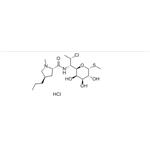 |
2024-04-26 | Clindamycin hydrochloride
21462-39-5
|
US $0.00 / kg | 25kg | 99% | 10tons | Henan Suikang Pharmaceutical Co.,Ltd. | |
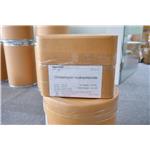 |
2024-04-16 | Clindamycin hydrochloride
21462-39-5
|
US $0.00-0.00 / KG | 1KG | USP, GMP | 5,000KG | Hangzhou Hyper Chemicals Limited | |
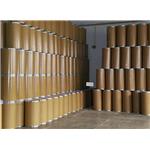 |
2024-04-07 | Clindamycin hydrochloride
21462-39-5
|
US $70.00-65.00 / kg | 1kg | 99% | 1t | Zibo Wei Bin Import & Export Trade Co. Ltd. |
-

- Clindamycin hydrochloride
21462-39-5
- US $0.00 / kg
- 99%
- Henan Suikang Pharmaceutical Co.,Ltd.
-

- Clindamycin hydrochloride
21462-39-5
- US $0.00-0.00 / KG
- USP, GMP
- Hangzhou Hyper Chemicals Limited
-

- Clindamycin hydrochloride
21462-39-5
- US $70.00-65.00 / kg
- 99%
- Zibo Wei Bin Import & Export Trade Co. Ltd.
21462-39-5(Clindamycin hydrochloride)Related Search:
1of4





